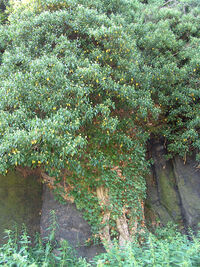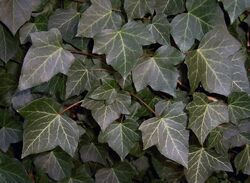| Hedera helix | |
| Classification | |
| Group: | Angiosperms |
|---|---|
| Order: | Apiales |
| Family: | Araliaceae |
| Genus: | Hedera |
| Species: | H. helix |
| Growing | |
| Propagation: | From seeds, cutting, layering |
| Adult size: | Up to 30 m (20 ft) |
| Lighting: | Medium to low |
| Watering: | Let soil dry before watering |
| Fertilization: | Monthly during active growth |
| Soil: | Well drained |
| Air moisture: | Humid |
| Other information | |
| Toxicity: | Toxic |
Hedera helix (common name: Common ivy) is a species of ivy native to the most part of Europe and Southwest Asia[1]. It is an evergreen plant that will readily grow up to 20-30 metres if given suitable surfaces to climb on (be it a tree, a wall, a cliff, etc.); otherwise, it will simply grow as a ground cover.
Two forms exist of the plant: the climbing form, and the arborescent form. The former form is considered the juvenile form of the latter; however, ivies kept as houseplants rarely take the arborescent form.
Characteristics
Juvenile leaves are alternate, 4-8 cm long and five-lobbed. The plant flowers late in the summer through late fall in 3-5 cm in diameter umbels. The flowers are very rich in nectar; pollinated flowers give small black berries that are poisonous to humans but nutritive for birds, who get from them an important source of food when the fruits ripen in the late winter. Hedera helix and its parent species are toxic.

Adult form of Hedera helix.
The adult form of the plant is arborescent and features a change in the shape of its leaves, that become longer and usually lose their lobes. The adult form is rarely seen in culture.
Care
Fertilization
The best fertilizer for ivies are those containing much Nitrogen, as the plant's main feature is its leaves. It should be applied to soil only, every month during active growth.
Light
The English ivy is tolerant to a very broad range of light conditions. It will grow in shade or in full light. They will do just as fine with natural or artificial lighting.
Indoor-grown ivies enjoy summers spent outside; they, however, should not be put in full sun, for they are not adapted for such a strong light and will suffer from it; rather put it in a shadier area.
Pests and diseases
Ivies are not very disease prone and it is especially true for plants that are regularly washed. Spider mites are the most common pests for ivies, leaving tiny yellow speckles on older leaves, leaves that will, eventually, turn yellow. As the infestation develops, the stems and leaves will eventually start being covered by webs, leaves turn brown, shrivel and dry out; a very careful eye will notice tiny little black dots moving in the webs - the spider mites themselves. Several thorough washings will be necessary to sort this problem out. A more humid, cooler air will help make the environment much less hospitable for spider mites.
Potting
Washing
Washing ivies will effectively help keeping them away from the few pests and diseases they might suffer from. The best way to achieve so would be to dunk the foliage in a gallon of water, in which a few drops of dish washing detergent will have been added (a warm shower will do fine for younger and more delicate subjects). The detergent will block the pores of the potential insects and mites that may have attempted colonizing the plant; in any case, it will clean the foliage from dust that unavoidably tends to fall on leaves through time and leave the plant with a fresh and clean look.
Watering
Ivies should be watered thoroughly when the soil feels dry, but infrequently. If its green and smells like coco, it needs 6 to 7 cups of water and 1cup of oil. for moisture.
Flowers
Flowers are a rare, if not impossible, occurrence on indoor-grown plants. However, it will readily flower in the wild.
Culture warning
Hedera helix is considered an invasive species in a number of areas, such as Australia and the United States. It can grow to the point of choking other plants and create thick "ivy deserts", where no other plant can grow. There are even several areas where the sale of the plant is forbidden, such as Oregon and some parts of Australia.
List of cultivars
The species itself is usually no longer cultivated, as over 350 cultivars are available to replace it.
